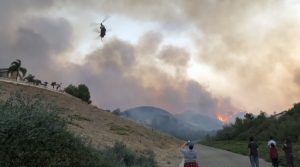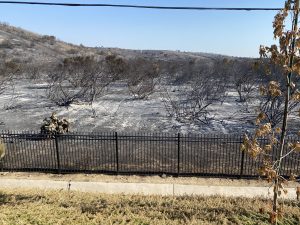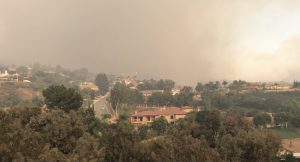
Tom Robershaw grew up in the backcountry of San Diego, a resident of Southern California for over 50 years. He’s a veteran when it comes to wildfires.
Yet when the Silverado Fire bloomed late October in the hills above his home in Foothill Ranch, CA, Robershaw grew concerned, despite a rock-solid evacuation plan. The ferocity of the smoke and flames was unexpected – yet evident of just how bad the fire problem in Southern California had become.
“(The fires have) gotten worse, I don’t think there’s any argument against that,” Robershaw said. “I guess the question is – what’s causing it?”
Jessica Goodrich, a junior Chapman sociology major, evacuated from her Irvine home to escape the Silverado blaze, which reached all the way up to her street. Her answer to Robershaw’s question? Climate change.
“The more we ignore the destruction of our environment and climate change, the more dangerous and rampant these wildfires and other natural disasters become,” Goodrich said.

Wildfires in Southern California spread quickly in part due to a lack of rainfall providing fuel for the flames, said Ramesh Singh, a Chapman University environmental science professor and expert in atmospheric pollution.
“The western part of the United States is becoming drier and drier,” Singh said. “That means the humidity in the air is going to decline, the rainfall is declining, and then (if) the atmosphere becomes dry there is a good chance of a forest fire occurring.”
In 2020, those effects have had catastrophic consequences on the Southern California landscape.
This year has been the worst for fires California has ever seen. A record 3.2 million acres have been burned, as reported by the Los Angeles Times. Of the 10 largest fires in the state’s history, eight have come within the last 10 years. Southern California has been particularly affected as of late, with the Silverado and Blue Ridge fires – extending from late October into early November – causing the fleeing of residents from thousands of homes in Irvine, Yorba Linda and Chino Hills.
On Oct. 26, all Chapman students and staff were notified of an immediate halt to in-person instruction on the Harry and Diane Rinker Health Science campus. The grounds were located – at one point during the progression of the blaze – just a block away from the Silverado Fire evacuation zone in Irvine.
Singh noted another dangerous side effect of fire season: the poor air quality and pollutants the smoke carries into the atmosphere. During the peak of the Silverado and Blue Ridge outbreaks, Orange County reached the highest possible score in the “Hazardous” tier of the EPA’s Air Quality Index.

That smoke has larger environmental implications than simply making it hard to breathe, however. As smoke carries to the south, it deposits pollutants from the fires into the ocean.
“Slowly, the ocean is becoming acidic,” Singh said of the consequences of Southern California fires. “It means you cannot go and swim … apart from that, marine life is going to be affected.”
Not just marine life – all wildlife. Amanda Shea, a freshman environmental science and policy major at Chapman, fears for the future of the Southern California ecosystem.
“I’m scared that our beautiful nature, animals, and resources we take for granted will slowly die off and eventually no one will be left to appreciate it,” Shea said. “I’m sad (future generations) won’t see the world the same way we can.”
The cycle of corporations’ dependency on harmful fuel and natural resources will be difficult to break, unless “governments globally agree to reform,” she said.
“But most (corporations) don’t take climate change as an urgent enough issue to push for, especially when it may compromise something else (beneficial),” Shea added.
Maddie Milla, president of Chapman’s Orange County Association of Environmental Professionals (OCAEP), believes individuals – particularly Chapman students – can do their part to help their Southern California environment by spreading awareness through social media and holding corporations accountable for their massive contributions to fossil fuels.
OCAEP Vice President Maya Cheav also suggests students eat locally, as the gas and carbon emissions created by frequent travel for food can contribute to worsening climate change.
“On an individual level, I know it’s hard to feel like you’re making a difference, like when you’re just turning off your lights,” Cheav said. “These things don’t have a huge impact on an (individual basis), but if more people do those things, it’ll start to add up.”

